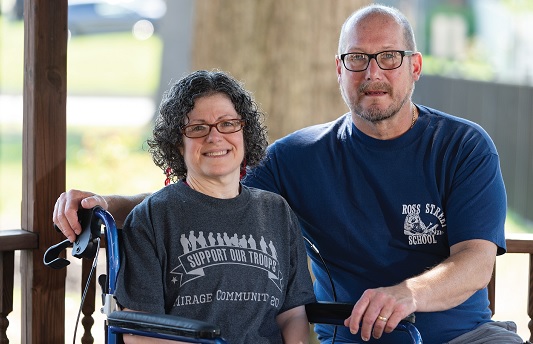“When you have wonderful people to take care of you, it makes the process so much easier."

Melissa Searles, 50, admits it was the embarrassment that stopped her from seeking medical help. Because she has had limited mobility since being diagnosed with multiple sclerosis 20 years ago, she spends much of her time lying down or sitting in a chair. She didn’t realize at first that this had led to a pressure wound on her tailbone—and she couldn’t have imagined it would take nearly two years to heal.
“My husband first noticed it and told me something didn’t look right back there,” she says. “We put Vaseline on it, but it kept getting worse. But because I was embarrassed—and scared—I wouldn’t go to the doctor. The wound festered, got bigger, and really hurt. Finally, after almost four months, I had to get help.”
In February 2018, Melissa went to the Emergency Department at Robert Wood Johnson University Hospital (RWJUH) Rahway, where she found out she’d need surgery to clean the wound and let the healing begin. “It was so deep the doctor said he could just about see my tailbone,” she remembers.
The Road to Healing
After three days, she was sent to a rehabilitation center, where she began treatment with a wound VAC (vacuum-assisted closure), a device that uses air pressure to reduce swelling and moisture in the wound. At the end of 100 days of Medicare coverage, Melissa was discharged and went home.
“Things were going all right for a while,” says Melissa. “I was on heavy antibiotics. I was on the wound VAC. Visiting nurses and a doctor came to my home to check on me.”
Throughout this ordeal, Melissa’s husband, Gregory, took an active role. “He was phenomenal, fantastic,” says Melissa. “Every time the nurse came, he would watch to see how things were done, in case there was a problem when they weren’t there.”

Then, in the spring of 2019, Melissa suddenly felt as if she were sitting on marbles. She’d developed a second wound—this one a deep abscess—in addition to the still-healing pressure injury.
Melissa credits surgeon Anthony Tonzola, MD, Medical Director of the Center for Wound Healing and Hyperbaric Therapy at RWJUH Rahway, with finally resolving her issues.
“The infection went long and deep,” says Dr. Tonzola. “We did surgery to open the area, irrigate everything, clean it up, and pack it.” The wound had to be kept open so it could heal from the inside outward.
Back at home, medications had to be inserted deep into the wound with long cotton swabs to keep it clean and bacteria-free. And, of course, Melissa had to be moved frequently to relieve the pressure on her backside. “It hurt,” she admits.
Slowly the wounds began to resolve. “Her husband was terrific,” says Dr. Tonzola. “He called with questions, made sure everything was done properly, and was really dedicated to her.”
Melissa’s last visit to Dr. Tonzola was this past November. “It took almost two years to finally heal both wounds, and I wasn’t sure they would ever get better,” Melissa says. “But thanks to Dr. Tonzola—and to Gregory—they did.”
Melissa has a message for others who find themselves in a similar situation. “Don’t ever wait so long to get help the way I did,” she says. “I was so embarrassed that I kept apologizing to the nurses. But they said, ‘We’ve seen everything, and we’re here to help you.’
“When you have wonderful people to take care of you, it makes the process so much easier. And everyone in the Rahway hospital was fantastic.”
What to Know About Pressure Wounds
What they are: “Pressure injury” is the current terminology for what people used to call “bed sores.” “These wounds tend to occur over bony prominences, where the skin and all the layers beneath it break down,” explains Jennifer Davis, RN, Inpatient Wound Care Coordinator at RWJUH Rahway.
How they start: Pressure wounds can occur on the lower back and tailbone as well as on the heels when people are bedridden, due to continual rubbing on sheets. For people who sit in a wheelchair much of the time, leaning on armrests can create pressure wounds on the elbows.
What to look for: The injury may start as redness that is “nonblanchable”— meaning it doesn’t turn white when you press on it, Davis explains. Or it may be purplish, having the appearance of a bruise. Sometimes, there is an open wound or blood blister.
What to do: “The number one way to prevent and resolve pressure injuries is to take the pressure off,” explains Davis. Medical professionals use special pressure distribution mattresses, positioning wedges, and pillows. “Wound care specialists also have an arsenal of other therapies available, including ointments and creams, special beds, advanced healing dressings, negative pressure wound therapy, and hyperbaric oxygen therapy,” Davis says. “But in order for those therapies to be effective, we always stress to our patients that they have to keep the pressure off the wound.”
Pressure injuries usually develop gradually and can heal on their own in the early stages if the source of pressure is removed. “But if redness or purplish areas don’t subside, or if there’s an opening in the skin,” says Davis, “then it’s time to see your primary care doctor or go to a local wound care center.”
To learn more about outpatient wound care, visit the Center for Wound Healing and Hyperbaric Therapy at RWJUH Rahway or call (732) 453-2915.